9.22: Surface Area and Volume of Cones
- Page ID
- 6303
Surface area equals the area of the circle plus the area of the outside of the cone
Cones
A cone is a solid with a circular base and sides that taper up towards a vertex. A cone is generated from rotating a right triangle, around one leg. A cone has a slant height.
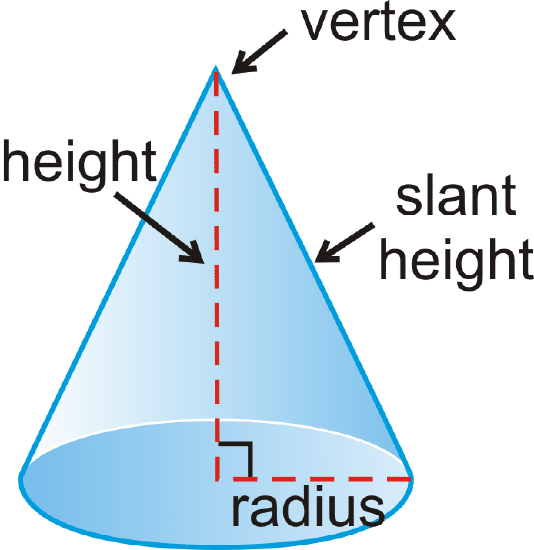
Surface Area
Surface area is a two-dimensional measurement that is the total area of all surfaces that bound a solid. The basic unit of area is the square unit. For the surface area of a cone we need the sum of the area of the base and the area of the sides.
Surface Area of a Right Cone: \(SA= \pi r^{2}+ \pi rl\).
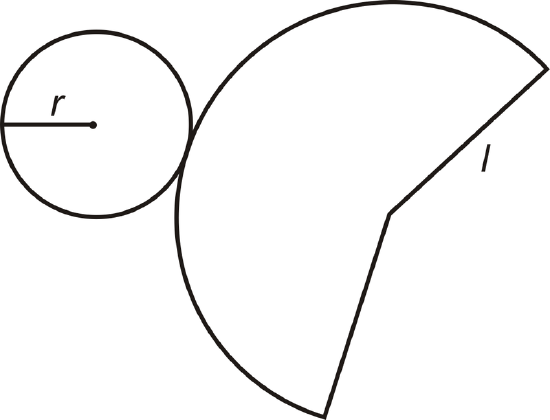
Area of the base: \(\pi r^{2}\)
Area of the sides: \(\pi rl\)
Volume
To find the volume of any solid you must figure out how much space it occupies. The basic unit of volume is the cubic unit.
Volume of a Cone: \(V=\dfrac{1}{3} \pi r^{2} h\).
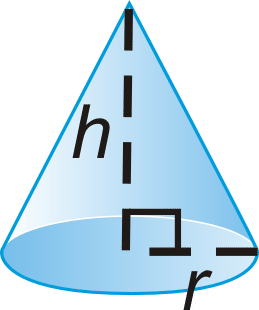
What if you were given a three-dimensional solid figure with a circular base and sides that taper up towards a vertex? How could you determine how much two-dimensional and three-dimensional space that figure occupies?
Example \(\PageIndex{1}\)
The surface area of a cone is \(36 \pi\) and the radius is 4 units. What is the slant height?
Solution
Plug what you know into the formula for the surface area of a cone and solve for \(l\).
\(\begin{aligned} 36 \pi&= \pi 4^{2}+ \pi 4l \\ 36&=16+4l \qquad \text{ When each term has a } \pi \text{, they cancel out.} \\ 20&=4l \\ 5&=l\end{aligned}\)
Example \(\PageIndex{2}\)
The volume of a cone is \(484 \pi \text{ cm}^{3}\) and the height is 12 cm. What is the radius?
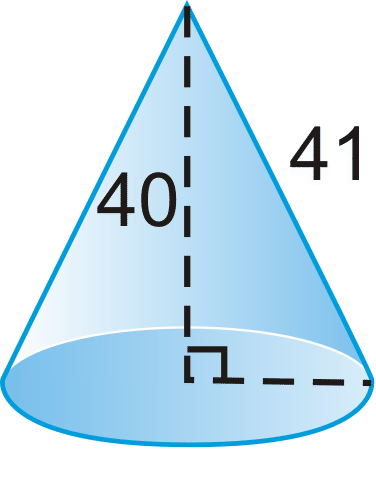
Solution
Plug what you know to the volume formula.
\(\begin{aligned} 484 \pi&=\dfrac{1}{3} \pi r^{2}(12) \\ 121&=r^{2} \\ 11 \text{ cm}&=r\end{aligned}\)
Example \(\PageIndex{3}\)
What is the surface area of the cone?
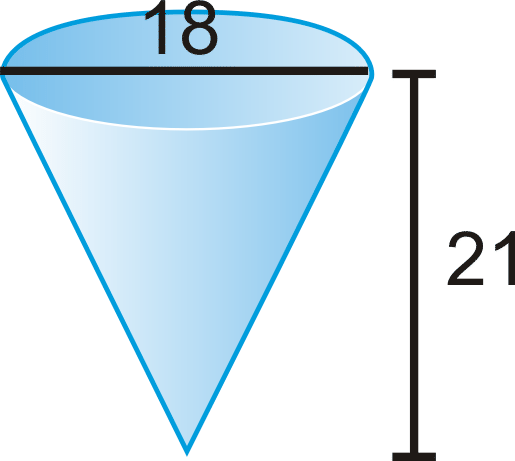
Solution
First, we need to find the slant height. Use the Pythagorean Theorem.
\(\begin{aligned} l^{2}&=9^{2}+21^{2} \\ &=81+441 \\ l&=\sqrt{522}\cong 22.85\end{aligned]\)
The total surface area, then, is \(SA= \pi 9^{2}+ \pi(9)(22.85)\cong 900.54 \text{ units}^{2}\).
Example \(\PageIndex{4}\)
Find the volume of the cone.
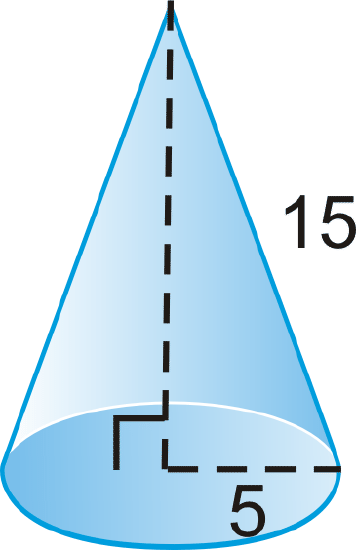
Solution
First, we need the height. Use the Pythagorean Theorem.
\(\begin{aligned} 5^{2}+h^{2}&=15^{2} \\ h&=\sqrt{200}=10\sqrt{2} \\ V&=13(5^{2})(10\sqrt{2}) \pi \cong 370.24 \text{ units}^{3}\end{aligned}\)
Example \(\PageIndex{5}\)
Find the volume of the cone.
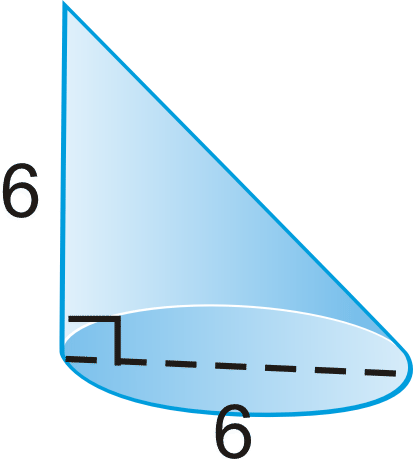
Solution
We can use the same volume formula. Find the radius.
\(V=\dfrac{1}{3} \pi(3^{2})(6)=18 \pi \cong 56.55 \text{ units}^{3}\)
Review
Use the cone to fill in the blanks.

- v is the ___________.
- The height of the cone is ______.
- x is a __________ and it is the ___________ of the cone.
- w is the _____________ ____________.
Sketch the following solid and answer the question. Your drawing should be to scale, but not one-to-one. Leave your answer in simplest radical form.
- Draw a right cone with a radius of 5 cm and a height of 15 cm. What is the slant height?
Find the slant height, \(l\), of one lateral face in the cone. Round your answer to the nearest hundredth.
-
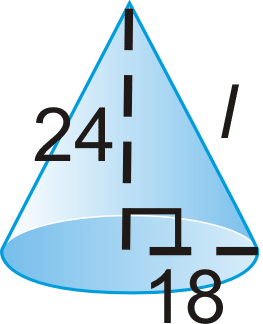
Figure \(\PageIndex{9}\)
Find the surface area and volume of the right cones. Round your answers to 2 decimal places.
-
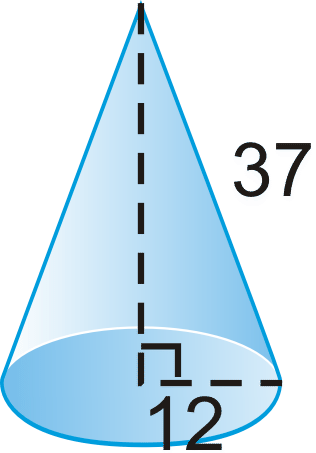
Figure \(\PageIndex{10}\) -
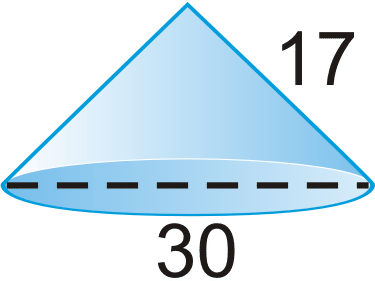
Figure \(\PageIndex{11}\) - If the lateral surface area of a cone is \(30 \pi \text{ cm}^{2}\) and the radius is 5 cm, what is the slant height?
- If the surface area of a cone is \(105 \pi \text{ cm}^{2}\) and the slant height is 8 cm, what is the radius?
- If the volume of a cone is\( 30 \pi \text{ cm}^{3}\) and the radius is 5 cm, what is the height?
- If the volume of a cone is \(105 \pi \text{ cm}^{3}\) and the height is 35 cm, what is the radius?
Review (Answers)
To see the Review answers, open this PDF file and look for section 11.6.
Vocabulary
| Term | Definition |
|---|---|
| cone | is a solid with a circular base and sides that taper up towards a vertex. A cone has a slant height. |
| Slant Height | The slant height is the height of a lateral face of a pyramid. |
Additional Resources
Interactive Element
Video: Surface Area of Cone - Overview
Activities: Cones Discussion Questions
Study Aids: Pyramids and Cones Study Guide
Practice: Surface Area and Volume of Cones

